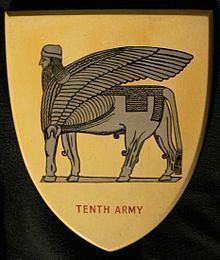Active 1942–1943 Engagements World War II | Engagement World War II | |
 | ||
People also search for | ||
The Tenth Army was a field army of the British Army during the Second World War created in Iraq and formed from the major part of "Paiforce" (Persia and Iraq Force). It was active in 1942 and 1943, and then disbanded.
In April 1941 British and Indian troops had been deployed to Iraq from India under the command of Lieutenant-General Sir Edward P. Quinan to protect British interests, in particular oil concessions, after a coup d'etat had brought to power a government sympathetic to the Axis powers. The force was known as Iraqforce and was engaged in the Anglo-Iraqi War which took place in April and May Iraqi rebellion and took part in the defeat of the Vichy forces in the subsequent Syria-Lebanon campaign. Later in 1941, the force took part in the Anglo-Soviet invasion of Iran to prevent the Axis elements from entering Persia, and preventing the possibility of the Germans gaining control of the Iraqi and Persian oil fields. Following this Iraqforce was renamed Paiforce (Persia and Iraq force).
After the campaigns of 1941, Quinan's headquarters was redesignated Tenth Army and its main task was the maintenance of the lines of communication to the Soviet Union from the Persian Gulf to the Caspian and the protection of the South Persian and Iraqi oilfields. Its badge was a golden Assyrian Ox with human head and eagle's wings (a Cherub Guardian). A variation of colouring of this badge was a white Ox on a pale blue background. Quinan was knighted in June 1942 and in August 1942, he was promoted to be a full general. Tenth Army was initially part of Middle East Command but became part of Persia and Iraq Command when it was activated in September 1942.
